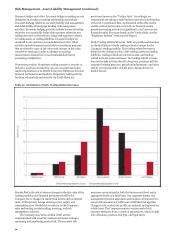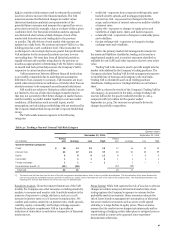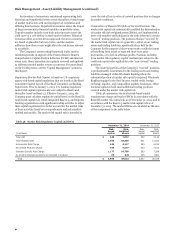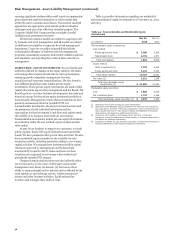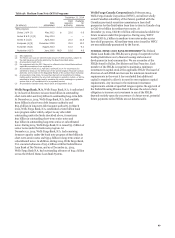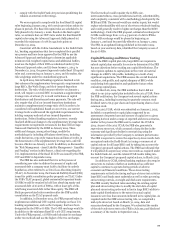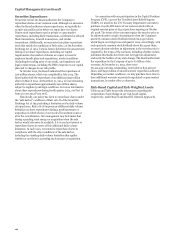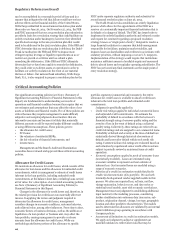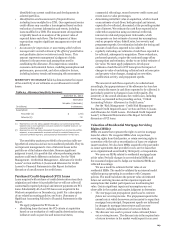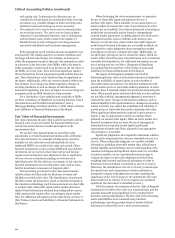Wells Fargo 2014 Annual Report Download - page 102
Download and view the complete annual report
Please find page 102 of the 2014 Wells Fargo annual report below. You can navigate through the pages in the report by either clicking on the pages listed below, or by using the keyword search tool below to find specific information within the annual report.
Capital Management
We have an active program for managing capital through a
comprehensive process for assessing the Company’s overall
capital adequacy. Our objective is to maintain capital at an
amount commensurate with our risk profile and risk tolerance
objectives, and to meet both regulatory and market expectations.
Our potential sources of capital primarily include retention of
earnings net of dividends, as well as issuances of common and
preferred stock. Retained earnings increased $14.7 billion from
December 31, 2013, predominantly from Wells Fargo net income
of $23.1 billion, less common and preferred stock dividends of
$8.4 billion. During 2014, we issued 96.3 million shares of
common stock. In April 2014, we issued 2 million Depositary
Shares, each representing 1/25th interest in a share of the
Company’s newly issued 5.9% Fixed-to-Floating Rate Non-
Cumulative Perpetual Class A Preferred Stock, Series S, for an
aggregate public offering price of $2.0 billion. In July 2014, we
issued 32 million Depositary Shares, each representing 1/1000th
interest in a share of the Company’s newly issued Non-
Cumulative Perpetual Class A Preferred Stock, Series T, for an
aggregate public offering price of $800 million. In addition, in
January 2015, we issued 2 million Depositary Shares, each
representing 1/25th interest in a share of the Company’s newly
issued 5.875% Fixed-to-Floating Rate Non-Cumulative Perpetual
Class A Preferred Stock, Series U, for an aggregate public
offering price of $2.0 billion. During 2014, we repurchased
183.1 million shares of common stock in open market
transactions, private transactions and from employee benefit
plans, at a cost of $9.2 billion. We also entered into a $750
million forward repurchase contract with an unrelated third
party in October 2014 that settled in January 2015 for 14.3
million shares. In addition, we entered into another $750 million
forward repurchase contract with an unrelated third party in
January 2015 that is expected to settle in second quarter 2015
for approximately 14.3 million shares. For additional
information about our forward repurchase agreements, see
Note 1 (Summary of Significant Accounting Policies) to Financial
Statements in this Report.
Regulatory Capital Guidelines
The Company and each of our insured depository institutions are
subject to various regulatory capital adequacy requirements
administered by the FRB and the OCC. Risk-based capital (RBC)
guidelines establish a risk-adjusted ratio relating capital to
different categories of assets and off-balance sheet exposures. At
December 31, 2014, the Company and each of our insured
depository institutions were “well-capitalized” under applicable
regulatory capital adequacy guidelines. See Note 26 (Regulatory
and Agency Capital Requirements) to Financial Statements in
this Report for additional information.
The RBC guidelines, which have their roots in the 1988
capital accord of the Basel Committee on Banking Supervision
(BCBS) establishing international guidelines for determining
regulatory capital, reflect broad credit risk considerations and
market-related risks, but do not take into account other types of
risk facing a financial services company. Our capital adequacy
assessment process contemplates a wide range of risks that the
Company is exposed to and also takes into consideration our
performance under a variety of stressed economic conditions, as
well as regulatory expectations and guidance, rating agency
viewpoints and the view of capital markets participants.
The market risk capital rule, effective January 1, 2013, is
reflected in the Company’s calculation of RWAs to address the
market risks of significant trading activities. In December 2013,
the FRB approved a final rule, effective April 1, 2014, revising the
market risk capital rule to, among other things, conform to the
FRB’s new capital framework finalized in July 2013 and
discussed below. For additional information see the “Risk
Management - Asset/Liability Management” section in this
Report.
In 2007, federal banking regulators approved a final rule
adopting revised international guidelines for determining
regulatory capital known as “Basel II.” Basel II incorporates
three pillars that address (a) capital adequacy, (b) supervisory
review, which relates to the computation of capital and internal
assessment processes, and (c) market discipline, through
increased disclosure requirements. We entered the “parallel run
phase” of Basel II in July 2012. During the “parallel run phase,”
banking organizations must successfully complete an evaluation
period under supervision from regulatory agencies in order to
receive approval to calculate risk-based capital requirements
under the Advanced Approach guidelines. The parallel run phase
will continue until we receive regulatory approval to exit parallel
reporting and subsequently begin publicly reporting our
Advanced Approach regulatory capital results and related
disclosures.
In December 2010, the BCBS finalized a set of further
revised international guidelines for determining regulatory
capital known as “Basel III.” These guidelines were developed in
response to the 2008 financial crisis and were intended to
address many of the weaknesses identified in the previous Basel
standards, as well as in the banking sector that contributed to
the crisis including excessive leverage, inadequate and low
quality capital and insufficient liquidity buffers.
In July 2013, federal banking regulators approved final and
interim final rules to implement the BCBS Basel III capital
guidelines for U.S. banking organizations. These final capital
rules, among other things:
• implement in the United States the Basel III regulatory
capital reforms including those that revise the definition of
capital, increase minimum capital ratios, and introduce a
minimum Common Equity Tier 1 (CET1) ratio of 4.5% and a
capital conservation buffer of 2.5% (for a total minimum
CET1 ratio of 7.0%) and a potential countercyclical buffer of
up to 2.5%, which would be imposed by regulators at their
discretion if it is determined that a period of excessive credit
growth is contributing to an increase in systemic risk;
• require a Tier 1 capital to average total consolidated assets
ratio of 4% and introduce, for large and internationally
active bank holding companies (BHCs), a Tier 1
supplementary leverage ratio of 3% that incorporates off-
balance sheet exposures;
• revise Basel I rules for calculating RWA to enhance risk
sensitivity under a standardized approach;
• modify the existing Basel II advanced approaches rules for
calculating RWA to implement Basel III;
• deduct certain assets from CET1, such as deferred tax assets
that could not be realized through net operating loss carry-
backs, significant investments in non-consolidated financial
entities, and MSRs, to the extent any one category exceeds
10% of CET1 or all such items, in the aggregate, exceed 15%
of CET1;
• eliminate the accumulated other comprehensive income or
loss filter that applies under RBC rules over a five-year
phase-in period beginning in 2014; and
100


